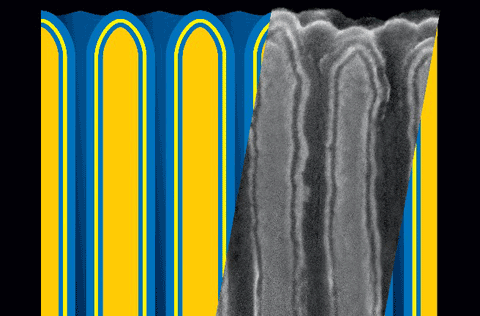Nano-capacitors: the root towards the super power battery
20 Aug, 2009 10:50 am
Nanostructured devices have the potential to serve as the basis for next-generation energy systems that make use of densely packed interfaces and thin films. Researchers have developed metal-insulator-metal nano-capacitors. It is possible to accommodate one million such tiny capacitors on one square centimeter area. The use of such capacitors in battery and other energy storage device may increase the efficiency and capacity of such devices enormously.
 |
Keeping these in mind, the Maryland researchers have developed a prototype of a super battery [1]. These super batteries target a particular problem in the energy requirements of modern society. That is, they help store large amounts of charge and help deliver very high bursts of energy when required.
Currently batteries that are used in electric or hybrid cars don’t hold enough energy for driving long distances. Besides, they take long time (several hours) to recharge. But, once fully developed, the energy storage device, descovered by the Maryland university researchers, will be able to make electric cars run for 500 km at a tress without intermediate recharging. Furthermore, this device — which combines the best features of conventional devices to store a large quantity of charge and release it rapidly — will be useful for storing electrical energy produced by alternative energy sources. Renewable energy sources like the sun and wind provide time-varying, unpredictable energy supply, and hence they must be captured and stored as electrical energy. Conventional devices to store and deliver electrical energy (batteries and capacitors) cannot achieve the desired combination of high energy density, high power and fast recharge.
At the heart of the new energy storage device, is a novel class of nanostructures. These nanostructures are basically tiny holes created on a thin film of the dimension of single atomic layer (few nanometers). These nanopores store energy just as a conventional capacitor stores energy, by storing charge in an insulator sandwiched between two metal plates. The scientists have successfully created capacitors inside the nanopores. It is possible to accommodate as many as one million tiny capacitors on one square centimeter area. Once these nanopores were created, the scientists deposited a metal, then an insulator, and then again a metal in them. These tiny metal-insulator-metal structures work exactly like electrostatic capacitors.
Now the challenge is what the scientist developed in the lab to take into the market. The challenge actually lies in producing such nano-capacitors on an industrial scale.
Reference:
[1] Parag Banerjee1, Israel Perez1, Laurent Henn-Lecordier1, Sang Bok Lee and Gary W. Rubloff; “Nanotubular metal–insulator–metal capacitor arrays for energy storage” Nature Nanotechnology 4, 292 - 296 (2009) (DOI: 10.1038/NNANO.2009.37).
-
22/04/09
Nanoparticles come at the top of occupational chemical risks
-
21/11/08
Future War Revisited
-
14/11/08
Nanotechnology's True Potential
-
31/10/08
Reinventing optical microscopy with nanotubes
-
29/09/08
Ups and Downs







 Read more
Read more